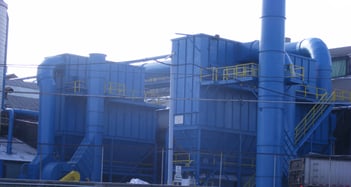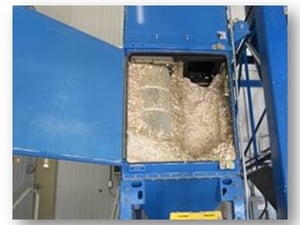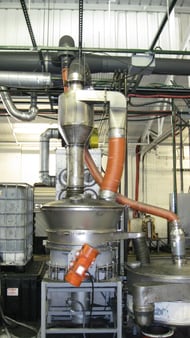Dry dust collectors and humidity don’t react well together. Baghouses and cartridge collectors operate by having dirty (dusty) air enter the housing. Multiple filters (bags or cartridges) are located in the housing. The air travels through the filter and then exits the dust collector. The filters are a mesh of fibers that allow air to travel through small holes, while dust is too large to pass. The dust builds up a layer (dust cake), further limiting the subsequent dust’s ability to pass through while allowing the air to pass. From time to time the dust collector will clean the filters by shaking them or using compressed air to expand them. This causes the outer layer of the dust cake to fall off.
Humidity can cause problems in the process described above. Humidity is a way to express the amount of water in the air, (the higher the humidity, the higher the amount of water in the air). When high humidity air enters a dust collector with fabric filters, there is a chance that the water vapor will condense and create water droplets or the dust on the filters will absorb the water as the airflow passes through. Many dusts change their physical properties when the water content increases. Some become sticky, some become hard like concrete, etc. When this happens to the dust cake, it affects the ability of the air to pass through and the ability of the dust to fall off during cleaning.
 When dust becomes sticky, it will adhere to neighboring dust particles and not want to fall during cleaning. Dust that becomes hard (like concrete) will prevent air from passing through. When one of these issues develop in a dust collector the pressure drop across the dust collector will increase. Over time, an increased pressure drop will lower the airflow being pulled through the system. This will decrease the airflow being picked up at hoods, therefore lowering dust collection at where operators are located.
When dust becomes sticky, it will adhere to neighboring dust particles and not want to fall during cleaning. Dust that becomes hard (like concrete) will prevent air from passing through. When one of these issues develop in a dust collector the pressure drop across the dust collector will increase. Over time, an increased pressure drop will lower the airflow being pulled through the system. This will decrease the airflow being picked up at hoods, therefore lowering dust collection at where operators are located.
Humidity can also be introduced in the dust collector in the compressed air. When air is compressed, the temperature of the air increases, thereby increasing the water content of the air. The compressed air is at its saturation point. As the air moves through the line, it cools, thereby condensing water in the system. If additional drying technology isn’t installed, the compressed air will have water droplets in it as it is used in the dust collectors. This will cause the filter cake to wet and cause issues as described above. This is why it is important to dry compressed air when dealing with dust that is affected by water.
 However, sometimes no matter how you treat your compressed air, you continue to have issues. This could be because the airline travels outside and in winter time it gets very cold. It could be because you are located near a large body of water, and humidity is high. One way to minimize the effect on your dust collector is to minimize the dust getting to your dust collector. Cyclone pre-filters are ideal for these applications. Cyclones collect dust and water droplets using centrifugal motion. This means they aren’t affected by the changes to the dust as a filter is. Cyclone pre-filters can often remove up to 80% of the dust before a dust collector with filters. This means you can lower the number of water droplets going into your dust collector and minimize the cleaning required, thereby not getting as much water from the compressed air system.
However, sometimes no matter how you treat your compressed air, you continue to have issues. This could be because the airline travels outside and in winter time it gets very cold. It could be because you are located near a large body of water, and humidity is high. One way to minimize the effect on your dust collector is to minimize the dust getting to your dust collector. Cyclone pre-filters are ideal for these applications. Cyclones collect dust and water droplets using centrifugal motion. This means they aren’t affected by the changes to the dust as a filter is. Cyclone pre-filters can often remove up to 80% of the dust before a dust collector with filters. This means you can lower the number of water droplets going into your dust collector and minimize the cleaning required, thereby not getting as much water from the compressed air system.
To learn more about the different types of Dust Collection methods, please contact our experts at 440-543-7400 or click on the button below to get our whitepaper, Top 5 Reasons to Use a Cyclone as a Pre-Filter.

